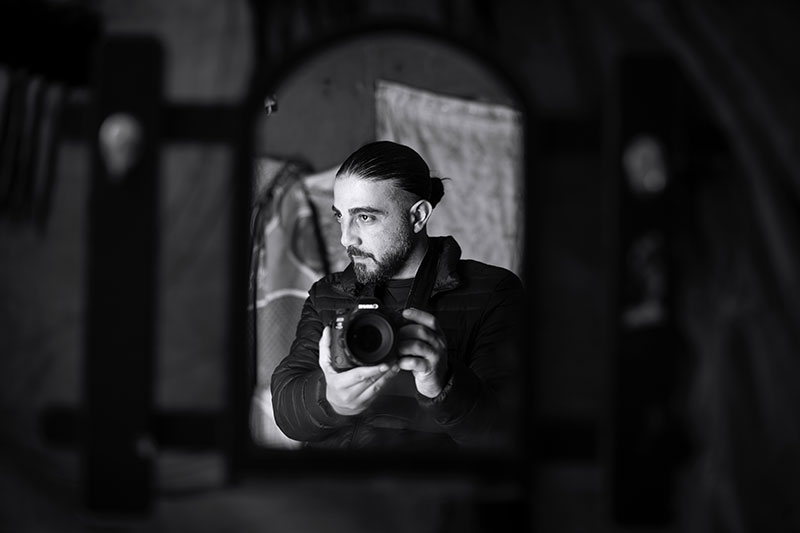
I had the amazing pleasure of interviewing Muhammed Muheisen, a world-renowned photographer, during his visit in Romania with the occasion of the extraordinary photo exhibition “Bearing Witness” in Bucharest. “Bearing Witness” photo exhibition by Muhammed Muheisen and Howard G. Buffett was on display from September 19th till September 26th at Palais Ghica Victoria and it showcased a collection of unique images, moments in time, captured by the two change-makers: Muhammed Muheisen and Howard G. Buffett, Chairman and CEO of the Howard G. Buffett Foundation. Those images took visitors on a visual journey of 50 untold stories spanning 25 years from different parts of the world. Through this exhibition, the two photographers wanted to create more awareness, change stereotypes, and raise the voices of those photographed. The exhibition was in display until now in Athens, Hague, Amsterdam, Bucharest and it will tour the world in order to change perceptions throughout the globe.
Muhammed Muheisen is a two-time Pulitzer Prize-winner, a National Geographic photojournalist and Explorer, founder and chairman of the Dutch non-profit organization Everyday Refugees Foundation, Global Ambassador for Jordan Tourism Board and Canon. Muheisen is a Jordanian national who was born in Jerusalem in 1981, graduated with a B.A. degree in journalism and political science. Named in 2013 by TIME Magazine as Best Wire Photographer. Since 2001 he has documented major events around the world, in Asia, Europe, the Middle East, Africa and the USA and for over a decade and a half he has been documenting the refugee crises in different parts of the world. Most recently he is the recipient of the 2023 National Geographic Wayfinder Award. I was amazingly lucky to have the chance to know him better, and I invite you to deep-dive into his universe:
Thank you very much for the opportunity of having this discussion in this amazing place in Bucharest in the front of a so well-deserved photograph that speaks of so much pain, suffering and loss. How was it for you to experience this and then to show it to the world in such format?
Thank you, Ana! It is an absolute pleasure to share with you my experience. At the end of the day I remind myself how lucky and blessed I am. I am the person always taking the picture, not the person in front of the camera. For me, there are not just pictures. These are voices, the are messeges and these are testimonies. I am a missioner and my mission is to change the world; one picture at a time, but the fact that I am a deep believer and the power of photography as a force is what keep me going. It’s not easy at the end of the day, but the big question that always rises is Did I give justice to the people? and What am I doing about it? So this is literally what keep me going.
This is like your engine, your inside engine that gives you the power to actually survive emotionally speaking through these disasters that you see. So the idea is to bring it to the people.
It aches sometimes at the end of the day that you didn’t help anybody but the idea that you gave something to someone is what keeps you also going. Helping one is better than none and that if you start believing in the difference you can make small or big, then believe me, that becomes your fuel to continue.
And what about the points in time when you say `I stop here, I decide that this photograph tell a story and I have to tell it to the world? What ist hat trigger, the stopping point when you freeze in time for eternity?
Absolutely. For example, you witness something terrible, a child in chains, let s say, this is one of the images that broke my heart because I am a mother and the children are the hope of the world, this is what you said at the opening exhibition… How do you decide to stop at the picture, how do you find these amazing moments in time that actually tell the story?
Thank you for explaining what photography is. The photo is a moment in time, it’s a moment in time that passes us by and to capture it you have to anticipate. So I don’t pass by and take pictures, I spend time, I invest, I get to know people and they become part of the landscape as there is nobody away to tell the story, then being part, and I believe that you are doing the same with your own projects. You cannot tell a story from the outside. To tell the story, you have to be on the inside, and in order to be on the inside, you have to win people’s trust and respect. So in order to be able to capture these pictures, you have to be welcomed.
I hope…you know, I always ask myself this question – Did I gave all of me? Did I do enough? Did I respect everybody? And that keeps me going, this moral compass inside us is actually what makes you the person or who you are. You want to succeed? You have to be honest. With yourself and with the people you photograph. That’s the key for me: respect.
Did you manage to keep contact with one of the subjects… the subject is such an impersonal word, but the persons, the souls that you capture in your photos?
I keep in touch with almost everybody that I had an opportunity to keep in touch with. I stay in touch with many of the children, with many of their parents and my last experience was in Syria and Romanian and Ukrainian war. I met a young Ukrainian girl, her name is Nicole and we managed to stay in touch, she is in Belgium, so for me that information is the most important. I approach the people and I seek their permission, I take their stories and I get their consent. And that allows me to come back again. I don’t like to be an outsider. I have to be an insider to get your attention and to have this picture of giving justice to the people photographed in it.
Aveți o serie de obiecte construite din lucruri vechi pe care le restaurați. Unde găsiți aceste obiecte și cum le re-integrați în contemporan?
În afară de obiectele pe care le realizăm din lemn nou, uneori folosim și lemn reciclat, dar nu restaurăm obiecte, este cu totul un alt domeniu și necesită multă pregătire. Am încercat doar de câteva ori, să vedem dacă ne place, dar îi lăsăm pe alții cu mai multă rabdare să se ocupe de restaurări. (nu știu exact la ce obiecte te referi, noi tot găsim obiecte în târgurile de vechituri, dar le luam pentru noi, nu le revindem. «Zâmbet larg».
This is amazing and this photography that you create brings justice to the world. I write about heritage. Can photography be considered a heritage element?
Can you imagine walking out one day without having a picture in the newspaper? What would you have learned about history if there was no photograph? So for me, the picture is the documentation from yesterday to today, tomorrow and the coming generations. We write history trough photographs, that is the power of the picture, it lives forever.
I truly believe that as well. Heritage has three components that draw people: the architectural, the aesthetical value, that is obviously underlined in all your photographs, and the historical value, which is quite mathematical: we can calculate it. There have been so many conflicts in the world and you have been documenting conflict for years and years. I think one of the most important values that is underlying in your photography is the memorial and symbolical value. Especially in our world, which is relying a lot on image, on transmitting images across borders.
Many of these pictures were taken 25 years ago and they look as if it’s just happened and that is the power of the picture, it literally lives forever and I always say, if it’s not documented, is as if it never occured. They are credible pictures. We live in a difficult time where we have the revolution of information – you have news, you have AI, so these photographs that documented with credibility, with integrity, this is your right source to what happened yesterday.
Indeed. Did you see in all these years of documentation that we go towards something good or are we increasing our conflict situation?
I am a very optimistical person, I am positive and I believe in colours, I believe in positive signs, I believe in the goodness in the people. For me there is nobody bad or good, everybody is good if you try to find that good seed in people. So I believe in humanity, I believe that if we are together we can do a lot of great things. One hand doesn’t clap without the other. But we need more hands to clap. Of course there are so many tragical stories but I choose to look at the ones that colour, I try so see the hope in some of the children s and I picture now the image with the balloons. Altough the story behind it is critical. How do you find this hope behind your photographs? Hope is all that I ve got. I am a storyteller, I am an artist, I am hopeful, I was a child one day and when I take these pictures I feel like a child again.


